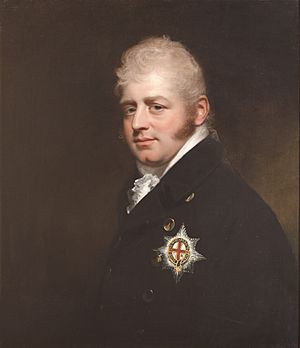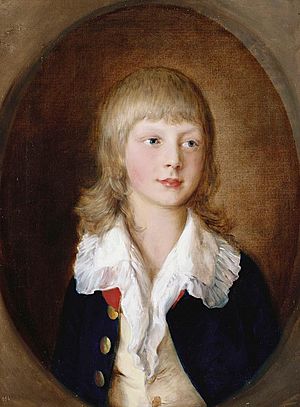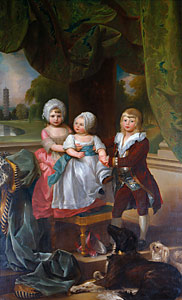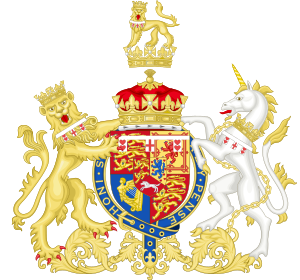Prince Adolphus, Duke of Cambridge facts for kids
Quick facts for kids Prince Adolphus |
|||||
|---|---|---|---|---|---|
| Duke of Cambridge (more) | |||||

Portrait by William Beechey
|
|||||
| Viceroy of the Kingdom of Hanover | |||||
| In office | 24 October 1816 – 20 June 1837 | ||||
| Monarch | |||||
| Predecessor | General von Bülow | ||||
| Born | 24 February 1774 Buckingham House, London |
||||
| Died | 8 July 1850 (aged 76) Cambridge House, Piccadilly |
||||
| Burial | 17 July 1850 St Anne's Church, Kew, Surrey 10 January 1930 |
||||
| Spouse |
Princess Augusta of Hesse-Kassel
(m. 1818) |
||||
| Issue |
|
||||
|
|||||
| House | Hanover | ||||
| Father | George III, King of the United Kingdom | ||||
| Mother | Charlotte of Mecklenburg-Strelitz | ||||
| Military career | |||||
| Allegiance |
|
||||
| Service/ |
|
||||
| Years of active service | 1791–1813 | ||||
| Rank | Field Marshal (active service) | ||||
| Commands held |
|
||||
| Battles/wars | |||||
Prince Adolphus, Duke of Cambridge, was a son of King George III and Queen Charlotte. He was born on February 24, 1774. He was their tenth child and seventh son.
From 1801 until his death, he held the important title of Duke of Cambridge. He also served as a Viceroy for the Kingdom of Hanover. He did this on behalf of his older brothers, George IV and William IV.
In 1818, Prince Adolphus married Princess Augusta of Hesse-Kassel. They had three children together: Prince George, Princess Augusta, and Princess Mary Adelaide.
Contents
Early Life and Education

Prince Adolphus was born in February 1774 at Buckingham House in London. This building is now known as Buckingham Palace. He was the youngest son of King George III and Queen Charlotte to survive childhood.
He was baptized on March 24, 1774, at St James's Palace. He had tutors at home until 1786. Then, he went to the University of Göttingen in Germany. His brothers, Prince Ernest and Prince Augustus, also studied there.
Military Career and Service
Adolphus began his military training in 1791 in Hanover, Germany. He served in the Flanders Campaign in 1793. His first battle was at Famars on May 23. He was hurt and captured at the Battle of Hondschoote on September 6, but was quickly rescued.
He became a British Army colonel in 1794. By 1798, he was a lieutenant general. In 1800, a village in Germany was named after him: Adolphsdorf.
During the War of the Second Coalition against France, Adolphus tried to stop the French from taking over Hanover. His efforts were not successful. In 1803, he was a senior army commander. He later returned to England.
In 1803, Adolphus became the commander-in-chief of the new King's German Legion. In 1813, he was promoted to Field Marshal. King George III also made him a Knight of the Garter in 1776. He was given the titles Duke of Cambridge, Earl of Tipperary, and Baron Culloden in 1801.
After Napoleon's empire fell, he became the Military Governor of Hanover. He served from 1813 to 1816. Then, he was the Governor General of Hanover from 1816 to 1837. He was also the patron of a Hanoverian army regiment called the Cambridge-Dragoner.
Marriage and Family
In 1817, Princess Charlotte of Wales died. She was the only legitimate grandchild of King George III. This meant there was a need for more heirs to the throne. The Duke of Cambridge was asked to help his older brother, the Duke of Clarence (who later became William IV), find a wife.
Once his brother found a bride, the Duke of Cambridge was free to find his own. He married his second cousin, Princess Augusta of Hesse-Kassel. They were married in Kassel, Hesse, on May 7, 1818. A second ceremony took place at Buckingham Palace on June 1, 1818.
Serving as Viceroy
From 1816 to 1837, the Duke of Cambridge was the viceroy of the Kingdom of Hanover. A viceroy is like a governor who rules a country or province as the representative of a king or queen. He ruled Hanover for his brothers, George IV and William IV.
When his niece, Queen Victoria, became the British Queen in 1837, the connection between the British and Hanoverian crowns ended. This was because Hanover followed a rule called Salic law. This law meant that women could not inherit the throne if there was a male heir. So, Ernest Augustus became the King of Hanover. The Duke of Cambridge then returned to Britain.
Later Life and Death
The Duke of Cambridge passed away on July 8, 1850. He died at Cambridge House in London. He was first buried at St Anne's Church, Kew. Later, in 1930, his remains were moved to St George's Chapel, Windsor Castle. His only son, Prince George, inherited his titles.
Titles and Honours
Titles and styles
- February 24, 1774 – November 24, 1801: His Royal Highness The Prince Adolphus
- November 24, 1801 – July 8, 1850: His Royal Highness The Duke of Cambridge
Honours
Prince Adolphus received many honours during his life. These included:
- Knight of the Garter (KG)
- Knight Grand Cross of the Bath (GCB)
- Grand Master of St Michael and St George (GCMG)
- Privy Counsellor (PC)
- Knight Grand Cross of the Royal Guelphic Order (GCH)
He also received honours from other countries, like Prussia and Russia.
Coat of Arms
The Duke's coat of arms was based on the Royal Arms of the House of Hanover. It had a special design to show his place in the royal family. His younger daughter, Princess Mary Adelaide, later used parts of his arms in her own family's coat of arms.
Children
The Duke and Duchess of Cambridge had three children:
| Name | Birth | Death | Notes |
|---|---|---|---|
| Prince George, Duke of Cambridge | March 26, 1819 | March 17, 1904 | He married Sarah Louisa Fairbrother in 1847. They had children, but their marriage was not officially recognized by law. |
| Princess Augusta of Cambridge | July 19, 1822 | December 4, 1916 | She married Frederick William, Grand Duke of Mecklenburg-Strelitz in 1843. They had children. |
| Princess Mary Adelaide of Cambridge | November 27, 1833 | October 27, 1897 | She married Francis, Duke of Teck in 1866. They had children, including Mary of Teck, who later became the Queen consort of the United Kingdom. |
Family Tree
| Dukes and Marquesses of Cambridge | ||||||||||||||||||||||||||||||||||||||||||||||||||||||||||||||||||||||||||||||||||||||||||||||||||||||||||||||||||||||||||||||||||||||||||||||||||||||||||||||||||||||||||||||||||||||||||||||||||||||||||||||||||||||||||||||||||||||||||||||||||||||||||||||||||||||||||||||||||||||||||||||||||||||||||||||||||||||||||||||||||||||||||||||||||||||||||||||||||||||||||||||||||||||||||||||||||||||||||||||||||||||||||||||||||||||||||||||||||||||||||||||||||||||||||||||||||||||||||||||||||||||||||||||||||||||||||||||||||||||||||||||||||||||||||||||||||||||||||||||||||||||||||||||||||||||||||||||||||||||||||||||||||||||||||||||||||||||||||||||||||||||||||||||||||||||||||||||||||||||||||||||||||||||||||||||||||||||||||||||||||||||||||||||||||||||||||||||||||||||||||||||||||||||||||||||||||||||||||||||||||||||||||||||||
|---|---|---|---|---|---|---|---|---|---|---|---|---|---|---|---|---|---|---|---|---|---|---|---|---|---|---|---|---|---|---|---|---|---|---|---|---|---|---|---|---|---|---|---|---|---|---|---|---|---|---|---|---|---|---|---|---|---|---|---|---|---|---|---|---|---|---|---|---|---|---|---|---|---|---|---|---|---|---|---|---|---|---|---|---|---|---|---|---|---|---|---|---|---|---|---|---|---|---|---|---|---|---|---|---|---|---|---|---|---|---|---|---|---|---|---|---|---|---|---|---|---|---|---|---|---|---|---|---|---|---|---|---|---|---|---|---|---|---|---|---|---|---|---|---|---|---|---|---|---|---|---|---|---|---|---|---|---|---|---|---|---|---|---|---|---|---|---|---|---|---|---|---|---|---|---|---|---|---|---|---|---|---|---|---|---|---|---|---|---|---|---|---|---|---|---|---|---|---|---|---|---|---|---|---|---|---|---|---|---|---|---|---|---|---|---|---|---|---|---|---|---|---|---|---|---|---|---|---|---|---|---|---|---|---|---|---|---|---|---|---|---|---|---|---|---|---|---|---|---|---|---|---|---|---|---|---|---|---|---|---|---|---|---|---|---|---|---|---|---|---|---|---|---|---|---|---|---|---|---|---|---|---|---|---|---|---|---|---|---|---|---|---|---|---|---|---|---|---|---|---|---|---|---|---|---|---|---|---|---|---|---|---|---|---|---|---|---|---|---|---|---|---|---|---|---|---|---|---|---|---|---|---|---|---|---|---|---|---|---|---|---|---|---|---|---|---|---|---|---|---|---|---|---|---|---|---|---|---|---|---|---|---|---|---|---|---|---|---|---|---|---|---|---|---|---|---|---|---|---|---|---|---|---|---|---|---|---|---|---|---|---|---|---|---|---|---|---|---|---|---|---|---|---|---|---|---|---|---|---|---|---|---|---|---|---|---|---|---|---|---|---|---|---|---|---|---|---|---|---|---|---|---|---|---|---|---|---|---|---|---|---|---|---|---|---|---|---|---|---|---|---|---|---|---|---|---|---|---|---|---|---|---|---|---|---|---|---|---|---|---|---|---|---|---|---|---|---|---|---|---|---|---|---|---|---|---|---|---|---|---|---|---|---|---|---|---|---|---|---|---|---|---|---|---|---|---|---|---|---|---|---|---|---|---|---|---|---|---|---|---|---|---|---|---|---|---|---|---|---|---|---|---|---|---|---|---|---|---|---|---|---|---|---|---|---|---|---|---|---|---|---|---|---|---|---|---|---|---|---|---|---|---|---|---|---|---|---|---|---|---|---|---|---|---|---|---|---|---|---|---|---|---|---|---|---|---|---|---|---|---|---|---|---|---|---|---|---|---|---|---|---|---|---|---|---|---|---|---|---|---|---|---|---|---|---|---|---|---|---|---|---|---|---|---|---|---|---|---|---|---|---|---|---|---|---|---|---|---|---|---|---|---|---|---|---|---|---|---|---|---|---|---|---|---|---|---|---|---|---|---|---|---|---|---|---|---|---|---|---|---|---|---|---|---|---|---|---|---|---|---|---|---|---|---|---|---|---|---|---|---|---|---|---|---|---|---|---|---|---|---|---|---|---|---|---|---|---|---|---|---|---|---|---|---|---|---|---|---|---|---|---|---|---|---|---|---|---|---|---|---|---|---|---|---|---|---|---|---|---|---|---|---|---|---|---|---|---|---|---|---|---|---|---|---|---|---|---|---|---|---|---|---|---|---|---|---|---|---|---|---|---|---|---|---|---|---|---|---|---|---|---|---|---|---|---|---|---|---|---|---|---|---|---|---|---|---|---|---|---|---|---|---|---|---|---|---|---|---|---|---|---|---|---|---|---|---|
|
||||||||||||||||||||||||||||||||||||||||||||||||||||||||||||||||||||||||||||||||||||||||||||||||||||||||||||||||||||||||||||||||||||||||||||||||||||||||||||||||||||||||||||||||||||||||||||||||||||||||||||||||||||||||||||||||||||||||||||||||||||||||||||||||||||||||||||||||||||||||||||||||||||||||||||||||||||||||||||||||||||||||||||||||||||||||||||||||||||||||||||||||||||||||||||||||||||||||||||||||||||||||||||||||||||||||||||||||||||||||||||||||||||||||||||||||||||||||||||||||||||||||||||||||||||||||||||||||||||||||||||||||||||||||||||||||||||||||||||||||||||||||||||||||||||||||||||||||||||||||||||||||||||||||||||||||||||||||||||||||||||||||||||||||||||||||||||||||||||||||||||||||||||||||||||||||||||||||||||||||||||||||||||||||||||||||||||||||||||||||||||||||||||||||||||||||||||||||||||||||||||||||||||||||
See also
 In Spanish: Adolfo de Cambridge para niños
In Spanish: Adolfo de Cambridge para niños
- British Royal Family
- House of Hanover
- Duke of Cambridge
- Cambridge Bay, Nunavut
- Adolphustown, Ontario, Canada.



